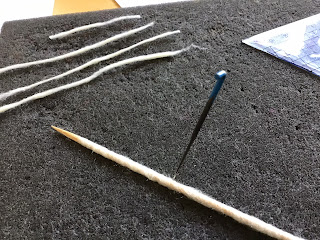My latest idea was to make a conjoined sun and moon face with needle felting. I sketched out my ideas and got going.
Monday, 9 November 2020
Here comes the sun
Saturday, 15 August 2020
Busy in the kitchen, beetroot soup and and elderberry cordial
Been busy in the kitchen today making beetroot,garlic, ginger and sweet potato soup. It’s so hot with garlicky yummyness. We have a weekly shop from Asda and I wanted to use up a few veggies, especially the large beetroot taking up all the room in the salad drawer!!!
It turned out amazing, I make my soups from just veggies, beetroot, carrot, sweet potato, broccoli stem, onion, 6 cloves garlic, courgette. I then add a flat dessert spoon of miso instead of stock and 2 tablespoons nutritional yeast, simmer til veggies are soft and liquidise.Yum!
I also made elderberry cordial from the lush elderberry trees nearby. We picked them yesterday and it took 2 hours to pick them off the stem, mainly using a fork.
Today I put them in a pan with water to cover and boiled them for 20 minutes, it is important to not drink elderberry raw as it contains cyanide. Cooking gets rid of this.
I strained the berries and added 1lb sugar to each pint of liquid and 12 cloves per pint. The recipe was from Eat weeds
Simmer again for 10 minutes and strain out the cloves.
Bottle adding cloves back in if you are keeping the drink for any length of time. I’m not a fan of cloves and it will all be gone by next week so skipped this step,
Friday, 3 July 2020
Passion flower
It’s an awesome book and I have gone back to it many times in the two years I have had it. The only problem for me is I use acrylic fibre which doesn’t wet felt. The book is a mixture of wet and needle felt so I adapt where I need to.
I made my prefelt by needlefelting. In the book wool is used so she makes prefelt by wetfelting, I can’t do this with acrylic fibre so I set up an audio book and just stab away at my felting mat which is covered in fibres. I made extra so I could make stamens by cutting them 2mm thick from a rectangle of felt.
Two problems occurred.
Firstly upon ironing the petals I had cut out from the prefelt they became too flimsy and see through. I decided to attach them to another layer for structure and strength. This gave me more work to do but was worth it as the petals are now pleasingly substantial.
Two layers of prefelt needled together.
The second problem was the stamens. When cut they became very delicate and broke in places. As you cannot just roll damp soapy acrylic fibres in your hands I had to find a new way to make a long strong stamen.
I decided to use a method I have used before to create lengths of fibre. This involves wrapping fibre around a long thin bbq skewer and stabbing around the skewer carefully to join the fibres together( be careful not to break your needle on the wood). When it’s felted push it off the skewer. You will be able to stretch it slightly to get a thinner rope. I then dipped the whole length in starch and left to dry.
I joined the two sets of petals by adding more fibre in the centre . I then cut up the stamens to 4mm and coloured them with blue and purple sharpie pens. I then felted the stamens around the centre. On top of this I felted a green circle with an aubergine ring.


















































